
Via Tiburtina is an ancient road in Italy leading east-northeast from Rome to Tivoli (Latin: Tibur) and then, with the Via Valeria, on to Pescara (Latin: Aternum).

Via Tiburtina is an ancient road in Italy leading east-northeast from Rome to Tivoli (Latin: Tibur) and then, with the Via Valeria, on to Pescara (Latin: Aternum).
It was probably built by the Roman censor Marcus Valerius Maximus in 307 BC [1] at the time of the conquest of the Aequi territory and later lengthened, probably in about 154 BC, by Marcus Valerius Messalla to the territories of the Marsi and the Aequi in the Abruzzo, as Via Valeria. Its total length was approximately 200 km from Rome to Aternum (the modern Pescara). It exited Rome through the Aurelian Walls at the Porta Tiburtina, and through the Servian Wall at the Porta Esquilina.
Historians assert that the Via Tiburtina must have come into existence as a trail during the establishment of the Latin League.[ citation needed ] It is difficult to determine the part of the course from Albulae Aquae to Tibur. [2] Though afterward it became an important thoroughfare, the extension of the Via Tiburtina beyond Tibur always retained its original name of Via Valeria.

There are the remains of several Roman bridges along the road, including the Ponte Lucano and Ponte Mammolo.

A former state road with the same name exists today and follows the same path.

Tivoli is a town and comune in Lazio, central Italy, 30 kilometres north-east of Rome, at the falls of the Aniene river where it issues from the Sabine Hills. The city offers a wide view over the Roman Campagna.

The Aequi were an Italic tribe on a stretch of the Apennine Mountains to the east of Latium in central Italy who appear in the early history of ancient Rome. After a long struggle for independence from Rome, they were defeated and substantial Roman colonies were placed on their soil. Only two inscriptions believed to be in the Aequian language remain. No more can be deduced than that the language was Italic. Otherwise, the inscriptions from the region are those of the Latin-speaking colonists in Latin. The colonial exonym documented in these inscriptions is Aequi and also Aequicoli. The manuscript variants of the classical authors present Equic-, Aequic-, Aequac-. If the form without the -coli is taken as an original, it may well also be the endonym, but to date further evidence is lacking.
Marcus Valerius Messalla Corvinus was a Roman general, author, and patron of literature and art.
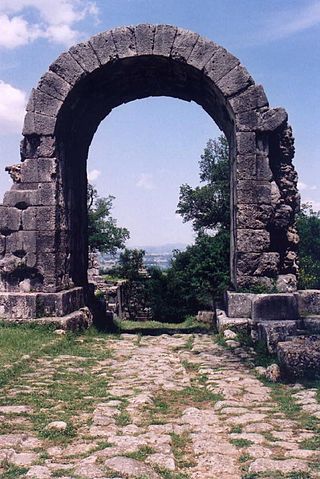
The Via Flaminia was an ancient Roman road leading from Rome over the Apennine Mountains to Ariminum (Rimini) on the coast of the Adriatic Sea, and due to the ruggedness of the mountains was the major option the Romans had for travel between Etruria, Latium, Campania, and the Po Valley. The section running through northern Rome is where Constantine the Great, allegedly, had his famous vision of the Chi Rho, leading to his conversion to Christianity and the Christianization of the Roman Empire.

Tusculum is a ruined Roman city in the Alban Hills, in the Latium region of Italy. Tusculum was most famous in Roman times for the many great and luxurious patrician country villas sited close to the city, yet a comfortable distance from Rome, notably the villas of Cicero and Lucullus.

Alba Fucens was an ancient Italic town located at 1,000 m (3,300 ft) elevation at the base of Monte Velino, approximately 6.5 km (4.0 mi) north of Avezzano, Abruzzo, central Italy. Its ruins can be found in the comune of Massa d'Albe.

The Via Clodia was an ancient high road of Italy. Situated between the Via Cassia and the Via Aurelia, it is different from them notably in that the latter was designed primarily for military long-haul, irrespective of settlements they met, but the Via Clodia was of short-range, intended for commercial traffic with the colonies in Etruscan lands.

The Via Aurelia is a Roman road in Italy constructed in approximately 241 BC. The project was undertaken by Gaius Aurelius Cotta, who at that time was censor. Cotta had a history of building roads for Rome, as he had overseen the construction of a military road in Sicily connecting Agrigentum and Panormus.

Avezzano is a city in the Abruzzo region, province of L'Aquila, Italy. It is the second most populous municipality in the province and the sixth in the region. It is the main commercial, industrial and agricultural centre of the Marsica area, with important high-tech industries and the Fucino Space Centre.

Via Nomentana is an ancient road of Italy, leading North-East from Rome to Nomentum, a distance of 23 km (14 mi). It originally bore the name "Via Ficulensis", from the old Latin village of Ficulea, about 13 km (8.1 mi) from Rome. It was subsequently extended to Nomentum, but never became an important high road, and merged in the Via Salaria a few kilometers beyond Nomentum. It is followed as far as Nomentum by the modern state road, but some traces of its pavement still exist.

The Via Valeria was an ancient Roman road of Italy, the continuation north-eastwards of the Via Tiburtina from Tibur. It probably owed its origin to Marcus Valerius Messalla, censor in 154 BC. A second Via Valeria, the Via Valeria of Sicily, connected Messina and Siracusa on the island of Sicily.

Carsoli is a town and comune in the province of L'Aquila, Abruzzo. The ancient Roman city lies 4 kilometres (2.5 mi) southwest of the modern town.
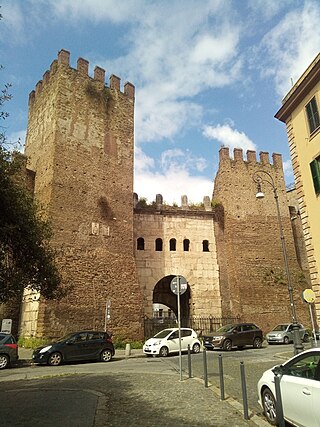
Porta Tiburtina or Porta San Lorenzo is a gate in the Aurelian Walls of Rome, Italy, through which the Via Tiburtina exits the city.
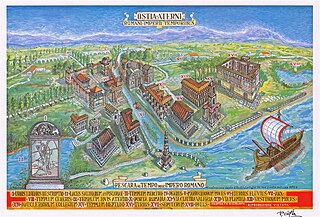
Aternum was a Roman town, on the site of Pescara, in Italy. Some historians also refer to Aternum with the name of Ostia Aterni, due to its location at the mouth of the river Aternus. Being connected to Rome through the Via Tiburtina and its extension the Via Valeria, Aternum played a crucial in connecting the capital to the Eastern provinces of the Empire. Its harbour, largely occupied by commercial and fishing ships, was supposedly also used for military purposes.
The Via Sublacensis was a Roman road constructed to connect Nero's palace in present-day Subiaco to Rome, splitting off from the Via Valeria near Varia, about 10 km northeast of Tivoli.

The Aqua Marcia is a 91 km (57 mi) long Roman aqueduct, and the longest of eleven aqueducts that supplied the city of Rome. The aqueduct was built between 144–140 BC. The still-functioning Acqua Felice from 1586 runs on long stretches along the route of the Aqua Marcia.
Caeso Fabius Vibulanus was consul of the Roman republic in 484, 481, and 479 BC. He had earlier held the office of quaestor parricidii in 485 BC in connection with the trial and execution of Spurius Cassius Vecellinus.
The Roman-Aequian wars were a series of wars during the early expansion of ancient Rome in central Italy fought against the Aequi, an Italic tribe located to their east.
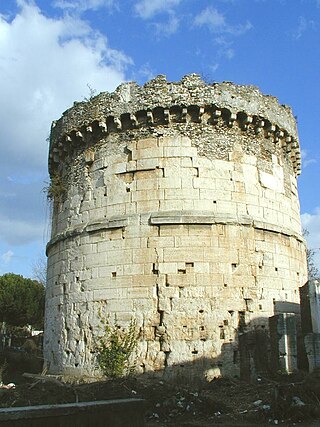
The Lucano bridge is a Roman stone bridge over the Aniene river in the Province of Rome, Italy, on the via Tiburtina. Coming from the direction of Rome, the bridge is found after Tivoli Terme and before Hadrian's Villa. This bridge was part of the project for the most endangered monuments of the World Monuments Fund for the year 2010.
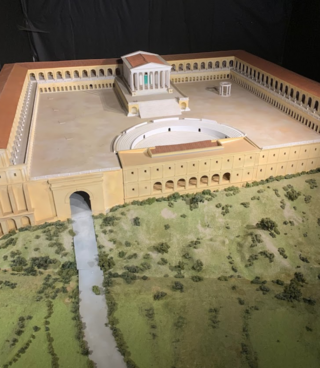
The Sanctuary of Hercules Victor in Tivoli (Italy) was one of the major complexes of the Roman Republican era built on the wave of the Hellenistic cultural influence after the final Roman conquest of Greece. It was built just outside the ancient city of Tibur and is the largest of Italic sanctuaries dedicated to Hercules, and the second in the whole Mediterranean after that of Cádiz in Spain. It was built between about 120 and 82 BC and was a masterpiece of Roman engineering with many innovations. Further building was done in the Augustan period especially in the theatre area. Augustus administered justice here on numerous occasions, under the arcades of the sanctuary.